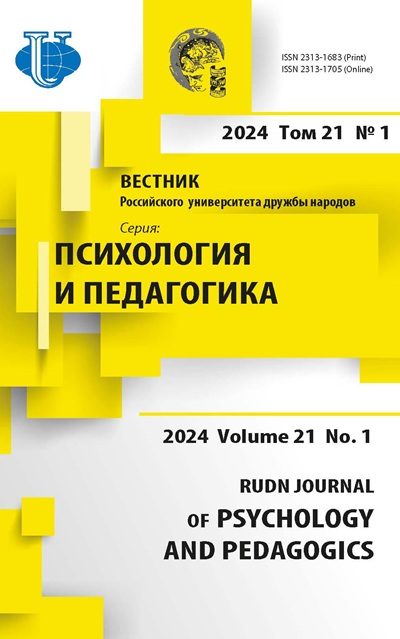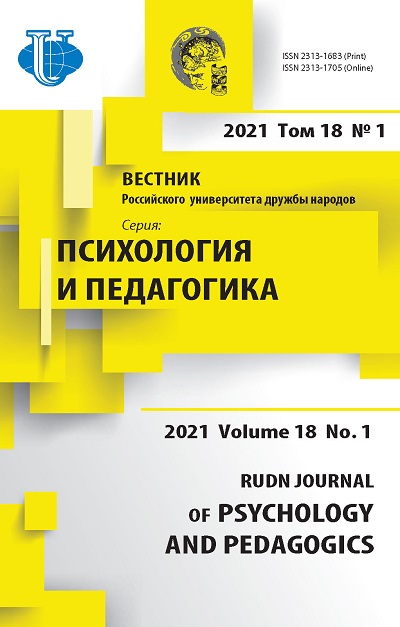Characteristics of Professional Burnout of Administrative and Managerial Personnel of Russian Educational Organizations in the Context of the Introduction of Innovative Technologies
- Authors: Belousova S.S.1
-
Affiliations:
- School No. 1514
- Issue: Vol 18, No 1 (2021)
- Pages: 194-216
- Section: PERSONALITY IN THE MODERN EDUCATIONAL ENVIRONMENT IN RUSSIA AND IN THE WORLD
- URL: https://journals.rudn.ru/psychology-pedagogics/article/view/26157
- DOI: https://doi.org/10.22363/2313-1683-2021-18-1-194-216
Cite item
Full Text
Abstract
The specifics of professional burnout of teachers engaged, in addition to their direct pedagogical activities, in the administration of their educational organizations are studied. The relevance of the raised research problem is determined by the significant socio-economic and political changes taking place in the modern education system: its intensive modernization and the introduction of innovative technologies in education have an impact not only on the content side of the educational process but also on its organization. The implementation of these innovations falls on the shoulders of the administrative and managerial personnel of schools, demanding huge emotional, intellectual and mental costs from the latter. The purpose of this study was to identify the characteristics of professional burnout and its symptoms in administrative and managerial personnel of educational organizations in relation to the severity of their psychological defenses and personality motivational profile. The sample was composed of 75 teachers (54 women, 21 men) in the position of school deputy director for studies and educational work. Their administrative work experience in an educational organization ranged from 1 to 23 years, the average age was 37.5 years. The study used a set of valid and reliable psychodiagnostic methods, including The Maslach Burnout Inventory (MBI) Questionnaire by Ch. Maslach and S.E. Jackson (adapted by N.E. Vodopyanova), The Life Style Index (LSI) by R. Plutchik, H. Kellerman and H.R. Conte (adapted by E.S. Romanov and L.R. Grebenshchikov) and Diagnosis of the Motivational Structure of Personality by V. Milman. The correlation analysis revealed that among teachers who additionally occupy in an educational institution, professional burnout is interconnected with the manifestation of psychological defenses of suppression, projection and intellectualization. Also, a relationship was established between professional burnout and a decrease in motivation for communication, general activity, creative activity and social usefulness of activities. The revealed specifics of professional activity and burnout of school deputy directors as well as the characteristics of their strategies for overcoming crisis situations in professional activity under conditions of changes and uncertainties open up opportunities for us to develop and implement programs on preventing professional burnout in this category of teachers and providing psychological support for their professional activities.
About the authors
Sofia S. Belousova
School No. 1514
Author for correspondence.
Email: grigoreva.sofya@mail.ru
Ph.D in Psychology, is educational psychologist
12 Krupskoi St, Moscow, 119311, Russian FederationReferences
- Arendachuk, I.V. (2016). Psychological factors of the manifestation of the style features of pedagogical communication. RUDN Journal of Psychology and Pedagogics, (3), 80–88 (In Russ.)
- Aronsson, G., Theorell, T., Grape, T., Hammarström, A., Hogstedt, C., Marteinsdottir, I., Skoog, I., Träskman-Bendz, L., & Hall, C. (2017). A systematic review including meta-analysis of work environment and burnout symptoms. BMC Public Health, 17(1). https://doi.org/10.1186/s12889-017-4153-7
- Barabanshchikova, V.V., & Klimova, O.A. (2015). Professional deformities in the sport of higher achievements. National Psychological Journal, (2), 3–12 (In Russ.)
- Bianchi, R., Schonfeld, I.S., & Laurent, E. (2015). Burnout–depression overlap: A review. Clinical Psychology Review, 36, 28–41. https://doi.org/10.1016/j.cpr.2015.01.004
- Bianchi, R., Schonfeld, I.S., Vandel, P., & Laurent, E. (2017). On the depressive nature of the “burnout syndrome”: A clarification. European Psychiatry, 41(1), 109–110. https://doi.org/10.1016/j.eurpsy.2016.10.008
- Bichurina, D. A. (2017). Leadership activities and mental burnout – analysis of scientific and methodological approaches. Concept, 2, 169–173. Retrieved May 19, 2020, from http://e-koncept.ru/2017/570036.htm (In Russ.)
- Blinkov, A.N., & Lebedintseva, O.I. (2018). Professional burnout as a result of a lack of professional readiness (based on the analysis of scientific literature). Akmeology, (1), 27–32 (In Russ.)
- Boiko, V.V. (1999). The syndrome of “emotional burnout” in professional communication. Saint Petersburg: Sudarynya Publ. (In Russ.)
- Burr, H., Hasselhorn, H.M., Kersten, N., Pohrt, A., & Rugulies, R. (2017). Does age modify the association between psychosocial factors at work and deterioration of self-rated health? Scandinavian Journal of Work, Environment & Health, 43(5), 465–474. https://doi.org/10.5271/sjweh.3648
- Formanyuk T.V. (1994). Emotional combustion syndrome as an indicator of a teacher's professional maladjustment. Voprosy Psikhologii, (6), 57–63 (In Russ.)
- Grishina, N.V. (2016). Existential approach to well-being: Empirical characteristics Psychological Research, 9(48), 10. (In Russ.)
- Harrison, J., & Dawson, L. (2016). Occupational Health: Meeting the Challenges of the Next 20 Years. Safety and Health at Work, 7(2), 143–149. https://doi.org/10.1016/j.shaw.2015.12.004
- Hartman, E.A. (1991). Boundaries in the Mind: A New Psychology of Personality. N.Y., 1991
- Hybels, C.F., Blazer, D.G., & Proeschold-Bell, R.J. (2018). Persistent Depressive Symptoms in a Population With High Levels of Occupational Stress. Journal of Psychiatric Practice, 24(6), 399–409. https://doi.org/10.1097/pra.0000000000000337
- Jood, K., Karlsson, N., Medin, J., Pessah-Rasmussen, Hã., Wester, P., & Ekberg, K. (2017). The psychosocial work environment is associated with risk of stroke at working age. Scandinavian Journal of Work, Environment & Health, 43(4), 367–374. https://doi.org/10.5271/sjweh.3636
- Kudinov, S.I., Kudinov, S.S., & Sedova, I.V. (2016). The role of responsibility in the emotional burnout of teachers at the initial stage of professionalization. RUDN Journal of Psychology and Pedagogics, (1), 26–41. (In Russ.)
- Lebedintseva, O.I. (2017). Relationship of emotional intelligence and professional burnout as a current issue of modern psychology. Living Psychology, 4(4), 337–346. https://doi.org/10.18334/lp.4.4.38660 (In Russ.)
- Leka, S. (2016). Psychosocial risk management: calamity or opportunity? Occupational Medicine, 66(2), 89–91. https://doi.org/10.1093/occmed/kqv173
- Litchfield, P., Cooper, C., Hancock, C., & Watt, P. (2016). Work and Wellbeing in the 21st Century. International Journal of Environmental Research and Public Health, 13(11), 1065. https://doi.org/10.3390/ijerph13111065
- Lopes, S.V., & Silva, M.C. da. (2018). Estresse ocupacional e fatores associados em servidores públicos de uma universidade federal do sul do Brasil. Ciência & Saúde Coletiva, 23(11), 3869–3880. https://doi.org/10.1590/1413-812320182311.28682015
- Maslach, C., & Jackson, S.E. (1986). The Maslach Burnout Inventory. Palo Alto, CA: Consulting Psychologists Press.
- Maslach, C., & Leiter, M.P. (2016). Understanding the burnout experience: recent research and its implications for psychiatry. World Psychiatry, 15(2), 103–111. https://doi.org/10.1002/wps.20311
- Mesters, P., Clumeck, N., Delroisse, S., Gozlan, S., Le Polain, M., Massart, A.C., & Pitchot, W. (2017). Professional fatigue syndrome (burnout). Part 2. From therapeutic management. Revue Medicale de Liege, 72(6), 301–307.
- Mikhailova, O.B., & Kulikova, A.S. (2016). Motivational and need states in teachers with different levels of psychoemotional burnout. Technologies of living systems, 13(7), 55–60 (In Russ.)
- Milman, V.E. (1990). Metod izucheniya motivatsionnoi sfery lichnosti. Praktikum po psikhodiagnostike. Psikhodiagnostika motivatsii i samoregulyatsii (pp. 23–43). Moscow: MSU Publ.
- Orel, V.E. (2006). Syndrome of “mental burning-out” and behavior and activity style features of professional. Siberian Psychological Journal, (23), 33–39 (In Russ.)
- Ozhiganova, G.V. (2018). Higher moral and creative capacities and productive life activity in the learning process. Vestnik of Kostroma State University. Series: Pedagogy. Psycho-logy. Sociokinetics, 24(3), 44–48 (In Russ.)
- Perlman, B., & Hartman, Е.А. (1982). Burnout: Summary and Future and Research. Human Relations, 35(4), 103–109.
- Pines, A., & Aronson, E. (1988). Career burnout: Causes and cures. New York: Free Press.
- Polyakova, O.B. (2016). Resilience of psychologists and instructors with a burn-out syndrome. Izvestia of the Ural Federal University. Series 3: Social Science, 11(4), 82–91 (In Russ.)
- Ravalier, J.M., & Walsh, J. (2018). Working conditions and stress in the English education system. Occupational Medicine, 68(2), 129–134. https://doi.org/10.1093/occmed/kqy017
- Rugulies, R. (2019). What is a psychosocial work environment? Scandinavian Journal of Work, Environment & Health, 45(1), 1–6. https://doi.org/10.5271/sjweh.3792
- Schaufeli, W.B., Desart, S., & De Witte, H. (2020). Burnout Assessment Tool (BAT) – Development, Validity, and Reliability. International Journal of Environmental Research and Public Health, 17(24), 9495. https://doi.org/10.3390/ijerph17249495
- Sedova, I.V. (2014). Psychological factors of emotional burnout of teachers. RUDN Journal of Psychology and Pedagogics, (1), 72–76 (In Russ.)
- Shilova, T.A., & Ponomareva, E.A. (2016). Social interaction of participants in the educational space. Systemic Psychology and Sociology, (2), 70–78 (In Russ.)
- Shiryaeva, V.V. (2017). Professional burnout as a component of the professional deformation of teachers of additional education of children. Innovative projects and programs in education, (5), 22–25. (In Russ.)
- Thisted, C.N., Labriola, M., Vinther Nielsen, C., Kristiansen, S.T., Strøm, J., & Bjerrum, M.B. (2018). Managing employees’ depression from the employees’, co-workers’ and employers’ perspectives. An integrative review. Disability and Rehabilitation, 42(4), 445–459. https://doi.org/10.1080/09638288.2018.1499823
- Trubnikova, N.I. (2016). Coping-behavior of the head of an educational organization as a factor in the emotional burnout syndrome of teachers. Vestnik psikhologii i pedagogiki Altaiskogo gosudarstvennogo universiteta, (2), 207–221. (In Russ.)
- Van Dierendonck, D., Schaufeli, W.B., & Sixma, H.J. (1994). Burnout among General Practitioners: A Perspective from Equity Theory. Journal of Social and Clinical Psychology, 13(1), 86–100. https://doi.org/10.1521/jscp.1994.13.1.86
- Vasserman, L.I., Eryshev, O.F., & Klubova, E.B. (2005). Psychological diagnostics of the life style index. Saint Petersburg: V M. Bekhterev SPbNIPNI Publ. (In Russ.)
- Vodopianova, N.E. (2009). Psychodiagnostics of stress. Saint Petersburg: Piter Publ. (In Russ.)
- Vodopianova, N.E. (2019). Psychology of personnel management. Mental burnout. Moscow: Yurait Publ. (In Russ.)
















